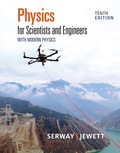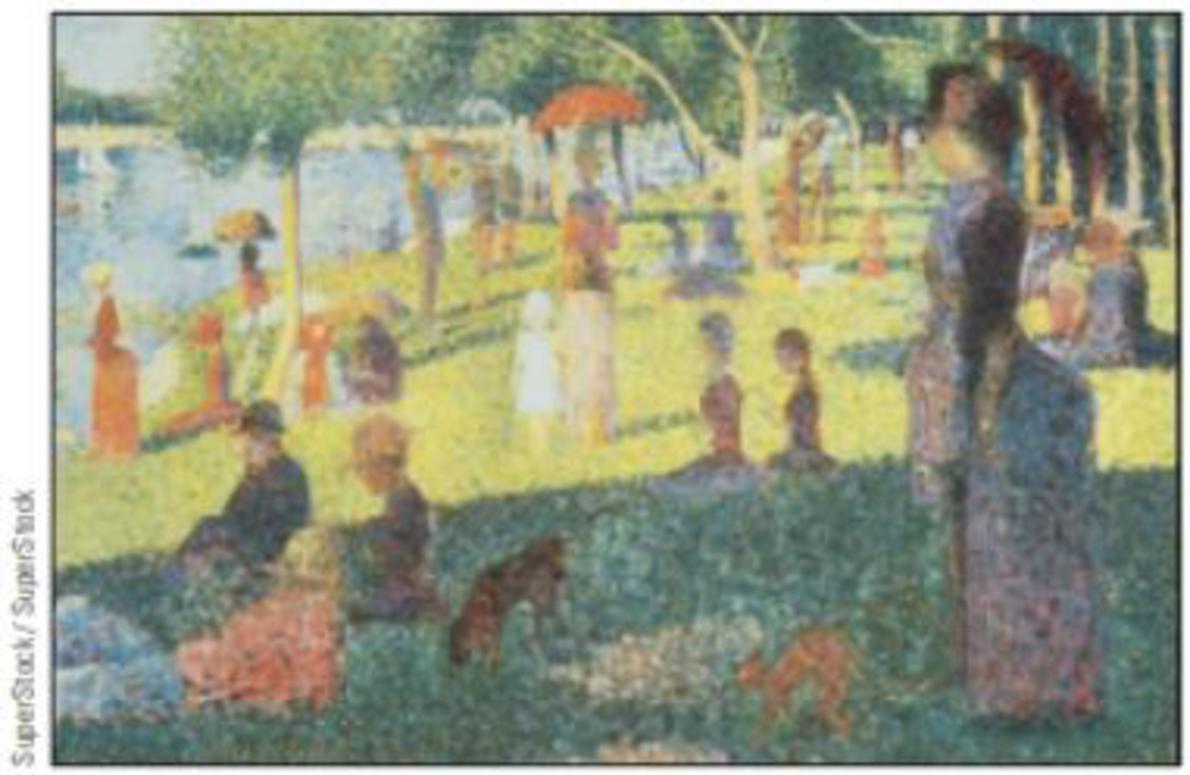
Physics for Scientists and Engineers with Modern Physics
10th Edition
ISBN: 9781337671729
Author: SERWAY
Publisher: Cengage
expand_more
expand_more
format_list_bulleted
Concept explainers
Textbook Question
Chapter 37, Problem 15P
Impressionist painter Georges Seurat created paintings with an enormous number of dots of pure pigment, each of which was approximately 2.00 mm in diameter. The idea was to have colors such as red and green next to each other to form a scintillating canvas, such as in his masterpiece, A Sunday Afternoon on the Island of La Grande Jatte (Fig. P37.15). Assume λ = 500 nm and a pupil diameter of 5.00 mm. Beyond what distance would a viewer be unable to discern individual dots on the canvas?
Figure P37.15

Expert Solution & Answer
Want to see the full answer?
Check out a sample textbook solution
Students have asked these similar questions
The Michelson interferometer can be used to measure the index of refraction of a gas by placing an evacuated transparent tube in the light path along one arm of the device. Fringe shifts occur as the
gas is slowly added to the tube. Assume 580-nm light is used, the tube is 5.40 cm long, and 152 fringe shifts occur as the pressure of the gas in the tube increases to atmospheric pressure. What is
the index of refraction of the gas? Hint: The fringe shifts occur because the wavelength of the light changes inside the gas-filled tube. (Give your answer to five decimal places.)
4.0
ress
SA
A thin film of magnesium fluoride (n = 1.38) is applied to glass (n = 1.50) with a thickness of 100
nm. For what visible wavelength of light will this coating act as nonreflecting? Assume normal
incidence.
O 491 nm
O 600 nm
O 504 nm
552 pm
Q Search
15 40
%5
6
Il app.honorlock.com is sharing your screen. Stop, sharing Hide
99+
3+
hp
103
a
malip
8
An optical plane wave with 20 = 532 nm propagates through an isotropic material
with unknown optical properties. The total optical phase accumulated per unit
length in the material is 1.8 x 10ª radians/mm and the optical power decreases by
90% when propagating over 2 mm. Calculate the complex index of refraction for
this material, n = n' - j.n".
Chapter 37 Solutions
Physics for Scientists and Engineers with Modern Physics
Ch. 37.2 - Suppose the slit width in Figure 37.4 is made half...Ch. 37.3 - Cats eyes have pupils that can be modeled as...Ch. 37.3 - Suppose you are observing a binary star with a...Ch. 37.4 - Ultraviolet light of wavelength 350 nm is incident...Ch. 37.6 - A polarizer for microwaves can be made as a grid...Ch. 37.6 - Prob. 37.6QQCh. 37 - Prob. 1PCh. 37 - Prob. 2PCh. 37 - Prob. 3PCh. 37 - In Figure 37.7, show mathematically how many...
Ch. 37 - Prob. 5PCh. 37 - What If? Suppose light strikes a single slit of...Ch. 37 - Prob. 7PCh. 37 - Coherent light of wavelength 501.5 nm is sent...Ch. 37 - Prob. 9PCh. 37 - Prob. 10PCh. 37 - What is the approximate size of the smallest...Ch. 37 - Prob. 12PCh. 37 - Prob. 13PCh. 37 - Prob. 14PCh. 37 - Impressionist painter Georges Seurat created...Ch. 37 - Prob. 16PCh. 37 - Consider an array of parallel wires with uniform...Ch. 37 - Prob. 18PCh. 37 - A grating with 250 grooves/mm is used with an...Ch. 37 - Show that whenever white light is passed through a...Ch. 37 - Light from an argon laser strikes a diffraction...Ch. 37 - Prob. 22PCh. 37 - You are working as a demonstration assistant for a...Ch. 37 - Prob. 24PCh. 37 - Prob. 25PCh. 37 - Prob. 26PCh. 37 - Prob. 27PCh. 37 - Prob. 28PCh. 37 - Prob. 29PCh. 37 - Prob. 30PCh. 37 - Prob. 31PCh. 37 - Prob. 32PCh. 37 - Prob. 33APCh. 37 - Laser light with a wavelength of 632.8 nm is...Ch. 37 - Prob. 35APCh. 37 - Prob. 36APCh. 37 - Prob. 37APCh. 37 - Prob. 38APCh. 37 - Prob. 39APCh. 37 - Prob. 40APCh. 37 - Prob. 41APCh. 37 - Prob. 42APCh. 37 - Prob. 43APCh. 37 - Prob. 44APCh. 37 - Prob. 45APCh. 37 - Prob. 46APCh. 37 - Prob. 47APCh. 37 - Prob. 48APCh. 37 - Two closely spaced wavelengths of light are...Ch. 37 - Prob. 50CPCh. 37 - Prob. 51CPCh. 37 - In Figure P37.52, suppose the transmission axes of...Ch. 37 - Prob. 53CP
Knowledge Booster
Learn more about
Need a deep-dive on the concept behind this application? Look no further. Learn more about this topic, physics and related others by exploring similar questions and additional content below.Similar questions
- Impressionist painter Georges Seurat created paintings with an enormous number of dots of pure pigment, each of which was approximately 2.00 mm in diameter. The idea was to have colors such as red and green next to each other to form a scintillating canvas, such as in his masterpiece, A Sunday Afternoon on the Island of La Grande Jatte (Fig. P37.15). Assume = 500 nm and a pupil diameter of 5.00 mm. Beyond what distance would a viewer be unable to discern individual dots on the canvas? Figure P37.15arrow_forwardA beam of 580-nm light passes through two closely spaced glass plates at close to normal incidence as shown in Figure P27.23. For what minimum nonzero value of the plate separation d is the transmitted light bright?arrow_forwardA ray of light consisting of blue light (wavelength 480 nm) and red light (wavelength 670 nm) is incident on a thick piece of glass at 80°. What is the angular separation between the refracted red and refracted blue beams while they are in the glass? (The respective indices of refraction for the blue light and the red light are 1.4636 and 1.4561.) O 0.27° 0.33° O 0.36° O 0.46° O 0.54°arrow_forward
- a) What is the minimum thickness of a film of glass (n=1.6) with air on both sides, that will reflect light at X = 600nm ? b) What is the minimum thickness of a film of glass (n=1.6), with air on both sides, that will NOT reflect light at λ = 660nm ?arrow_forwardProblem 8: A pilot at an altitude of h = 4700 m looks down at the ground. His eye has an aperture of D = 2.1 mm and index of refraction of n = 1.31. His eye can see wavelengths up to i = 713 nm. Randomized Variables h = 4700 m D= 2.1 mm n = 1.31 2 = 713 nm Part (a) Write an expression, in terms of h, D, and n, for the minimum separation d two objects on the ground can have and still be distinguishable at the wavelength 2. d = 7 | 8 HOME d D 4 56 g h 1 | 2 3 1 1 k +| - END m P vol BACKSPACE DEL CLEAR n Submit Hint Feedback I give up! Part (b) Calculate the separation d, in meters.arrow_forwardCh26,P24arrow_forward
- Impressionist painter Georges Seurat created paintings with an enormous number of dots of pure pigment, each of which was approximately 2.00 mm in diameter. The idea was to have colors such as red and green next to each other to form a scintillating canvas, such as in his masterpiece, A Sunday Afternoon on the Island of La Grande Jatte (figure below). Assume 1 = 420 nm and a pupil diameter of 4.90 mm. Beyond what distance would a viewer be unable to discern individual dots on the canvas? m SuperStock/SuperStockarrow_forwardThe index of refraction of a glass rod is 1.48 at T = 20.0°C and varies linearly with temperature, with a coefficient of 2.50 x 10-5/C°. The coefficient of linear expansion of the glass is 5.00 x 10-6/C°. At 20.0°C the length of the rod is 3.00 cm. A Michelson interferometer has this glass rod in one arm, and the rod is being heated so that its temperature increases at a rate of 5.00 C°/min. The light source has wavelength λ = 589 nm, and the rod initially is at T = 20.0°C. How many fringes cross the field of view each minute?arrow_forwardThe X-ray powder pattern for a silvery-grey metal has reflections at 0 = 20.25°, 29.30°, 36.82°, 43.81°, 50.69°, 58.00°, 66.30°, and other larger angles when Cu Ka X-rays are used (A = 154.05 pm). (a) What type of cubic crystal is formed by the metal? (b) What is the volume of the metal's unit cell (in cubic Å) at this temperature?arrow_forward
- A parallel X-ray beam is diffracted by sodium chloride. Strong first-order is obtained when the Bragg angle (the angle between the crystal planes and the emerging beam) is 6º 50’. The distance between the planes that are in the reflection position in the crystal is 2,8 Å. 1 angstron = 1 Å = 0,1 nm. a) What is the wavelength of X-rays?arrow_forwardThe index of refraction of a glass rod is 1.48 at T = 20.0°C and varies linearly with temperature, with a coefficient of 2.50 x 10-5C⁰-1. The coefficient of linear expansion of the glass is 5.00 x 10-6C⁰-1. At 20.0 °C the length of the rod is 2.80 cm. A Michelson interferometer has this glass rod in one arm, and the rod is being heated so that its temperature increases at a rate of 5.00 C°/min. The light source has wavelength λ = 569 nm, and the rod initially is at T = 20.0°C. Part A How many fringes cross the field of view each minute? ΔΝ = Submit ΤΙ ΑΣΦ Request Answer < Return to Assignment Provide Feedback ? fringes/minutearrow_forwardOften in optics scientists take advantage of effects that require very high intensity light. To get the desired effect a scientist uses a laser with power P = 0.0065 W to reach an intensity of I = 170 W/cm2 by focusing it through a lens of focal length f = 0.11 m. The beam has a radius of r = 0.0011m when it enters the lens. Randomized VariablesP = 0.0065 WI = 170 W/cm2f = 0.11 mr = 0.0011 Part (a) Express the radius of the beam, rp, at the point where it reaches the desired intensity in terms of the given quantities. (In other words, what radius does the beam have to have after passing through the lens in order to have the desired intensity?) Part (b) Give an expression for the tangent of the angle that the edge of the beam exits the lens with with respect to the normal to the lens surface, in terms of r and f? Part (c) Express the distance, D, between the lens's focal point and the illuminated object using tan(α) and rp. Part (d) Find the distance, D, in centimeters.…arrow_forward
arrow_back_ios
SEE MORE QUESTIONS
arrow_forward_ios
Recommended textbooks for you
 Physics for Scientists and EngineersPhysicsISBN:9781337553278Author:Raymond A. Serway, John W. JewettPublisher:Cengage Learning
Physics for Scientists and EngineersPhysicsISBN:9781337553278Author:Raymond A. Serway, John W. JewettPublisher:Cengage Learning Physics for Scientists and Engineers with Modern ...PhysicsISBN:9781337553292Author:Raymond A. Serway, John W. JewettPublisher:Cengage Learning
Physics for Scientists and Engineers with Modern ...PhysicsISBN:9781337553292Author:Raymond A. Serway, John W. JewettPublisher:Cengage Learning Principles of Physics: A Calculus-Based TextPhysicsISBN:9781133104261Author:Raymond A. Serway, John W. JewettPublisher:Cengage Learning
Principles of Physics: A Calculus-Based TextPhysicsISBN:9781133104261Author:Raymond A. Serway, John W. JewettPublisher:Cengage Learning Physics for Scientists and Engineers: Foundations...PhysicsISBN:9781133939146Author:Katz, Debora M.Publisher:Cengage Learning
Physics for Scientists and Engineers: Foundations...PhysicsISBN:9781133939146Author:Katz, Debora M.Publisher:Cengage Learning

Physics for Scientists and Engineers
Physics
ISBN:9781337553278
Author:Raymond A. Serway, John W. Jewett
Publisher:Cengage Learning

Physics for Scientists and Engineers with Modern ...
Physics
ISBN:9781337553292
Author:Raymond A. Serway, John W. Jewett
Publisher:Cengage Learning

Principles of Physics: A Calculus-Based Text
Physics
ISBN:9781133104261
Author:Raymond A. Serway, John W. Jewett
Publisher:Cengage Learning

Physics for Scientists and Engineers: Foundations...
Physics
ISBN:9781133939146
Author:Katz, Debora M.
Publisher:Cengage Learning
Convex and Concave Lenses; Author: Manocha Academy;https://www.youtube.com/watch?v=CJ6aB5ULqa0;License: Standard YouTube License, CC-BY